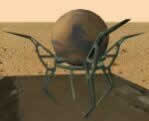Dark
and dusty, Phobos and Deimos orbit close to their parent planet.
The surface of these tiny Martian moons are pitted with large
craters and covered by a loose layer of broken rock, absorbing
almost all sunlight that reaches them. The moons are probably
small asteroids - cosmic debris left over from the formation of
the solar system - that were later snared by Mars' gravitational
pull. The trap is a lethal one for Phobos: Its orbit is decaying
and it is on a collision course with the red planet.
|
| Tiniest
Moons |
Small,
dark and fast-moving, the two Martian moons went unnoticed in
the blackness of space until 1877, when U.S. astronomer Asaph
Hall picked them out as mars made a particularly close approach
to earth. For the time, it was quite an achievement. Phobos and
Deimos are among the smallest known satellites in the solar system.
To small to have formed in a regular spherical shape, they only
measure about 16 by 12 miles and 10 by 6 miles respectively.
|
From
earth, even the most powerful telescope can make out no more of
the moons than dim spots. For the first detailed view of Phobos
and Deimos, astronomers had to wait for the U.S. Mariner 9 probe
in 1971. Mariner's pictures pictures were followed by more images
taken by the Viking 1 Orbiter as it neared Mars in 1976 - the
centennial of the moons' discovery.
|
Unlike
Earth's moon - a chunk of metallic rock that was probably ripped
from its parent planet early in its creation - the Martian moons
seem to be adopted companions, stray asteroids that passed to
close to Mars that they have been trapped by its gravity.
|
| A
Textured History |
The
surface of Phobos is more dramatic, testimony to a turbulent impact
history. It is covered in deep ridges, steep hills and numerous
craters, one of which - the six-mile-wide Stickney - stretches
across almost half of the moon's diameter. Stickney would be visible
from the surface of Mars.
|
Phobos
orbits at a mean distance of only 5,830 miles from the planet's
center, and appears in the sky as almost half the size of a full
Moon seen from Earth - although it is much darker. Deimos, orbiting
at 14,580 miles, shows up in the Martian sky as a tiny disk, only
just discernible to the naked eye.
|
Phobos
and Deimos both orbit east to west, but as seen from the surface
of mars, they seem to travel in opposite directions. This apparent
paradox is caused by the orbital periods of the two moons. Phobos
whizzes around Mars in just 7 hours and 39 minutes, so it circles
the planet more than four times in the course of the Martian day
of 24 hours 37 minutes. But Deimos travels slower than Mars rotates.
Left behind in the sky, it appears to move in a easternly direction
|
| Phobos
Crashes to Mars ? |
While
Deimos orbits at a safe distance from Mars, Phobos is spiraling
slowly toward eventual destruction. The planet's gravitational
pull is reeling in the moon at a rate of 60 feet per century.
But collision between Phobos and Mars may never occur - the moon
may suffer the fate of being broken up by the planet's tidal forces.
|
As
Phobos orbits around Mars, the side of the moon that faces the
planet is subjected to a greater gravitational force than the
opposite side. The difference between the forces puts the little
moon under a constant strain that could be enough to tear it apart
|
Phobos
orbits close to the Roche limit - the point where a planet's
tidal force is powerful enough to destroy a moon. Whether Phobos
will be demolished in this way depends upon its cohesive strength.
The moon's density suggests that, like many asteroids, its probably
consists of carboncaceous chondrite and pea-size nodules of various
minerals. This composition would make the moon brittle and likely
to crack and fracture.
|
The
largest crater on Phobos, six mile wide Stickney Crater, may offer
clues to the moon's cohesive strength. If the mood can withstand
such a large impact, it may be able to resist Mars' tidal forces
- at least for a long time to come. But Phobos' orbit will continue
to decay under the influence of Mars' gravitational field. If
Phobos remains in one piece, it may be pulled through the thin
Martian atmosphere before finally crashing onto the planet's surface.
|
Alternately,
the enormous force of the impact that produced Stickney may also
have weakened Phobos, and the large grooves that run outward from
the crater may be fractures. With so many splits, the moon may
fall victim to Mars' tidal forces, ending up as a rocky ring of
debris around the planet. Either way, astronomers have plenty
of time to prepare for the dramatic event: Phobos is expected
to stay in one piece for at least another 40 million years.
|






